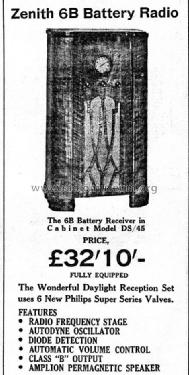Zenith 6B Cabinet model DS/45
Zenith Radio Co. Ltd.; Sydney, NSW
- Paese
- Australia
- Produttore / Marca
- Zenith Radio Co. Ltd.; Sydney, NSW
- Anno
- 1935
- Categoria
- Radio (o sintonizzatore del dopoguerra WW2)
- Radiomuseum.org ID
- 211543
- Numero di tubi
- 6
- Principio generale
- Supereterodina con stadio RF; ZF/IF 465 kHz
- Gamme d'onda
- Solo onde medie (OM).
- Tensioni di funzionamento
- Batterie (di accumulatori e/o a secco)
- Altoparlante
- AP magnetodinamico (magnete permanente e bobina mobile)
- Materiali
- Mobile in legno
- Radiomuseum.org
- Modello: Zenith 6B [Cabinet model DS/45] - Zenith Radio Co. Ltd.; Sydney,
- Forma
- Console, con gambe d'appoggio basse (< 50%).
- Annotazioni
-
ZENITH 6B BATTERY RECEIVER
New Series
(RADIO & ELECTRICAL MERCHANT, 8/3/1935.)
This is the latest battery receiver manufactured by the Zenith Radio Co. Ltd. and represents the culmination of many months of experimental work. Prior to releasing this receiver samples were sent to a number of country dealers and also to interstate agents who all reported remarkably good results. The receiver was given an exhaustive test by Mr. A. J. Ryan of Station 2CA Canberra, and he reports exceptionally good daylight reception obtained from all Sydney A and B class stations, also from Melbourn stations. No interference was experienced from his own station with a power of 500 watts which speaks well for the selectivity and sensitivity of this receiver.
A report was also received from Blayney Motors reporting 32 stations in daylight. The new Philips range of of 2 volt metal coated tubes are employed and automatic voltage control is obtained by means of the KBC1. Briefly the circuit is as follows:- A KF2 is used as an R.F. amplifier followed by a 15 as an autodyne feeding into another KF2 as an A.F. amplifier at an intermediate frequency of 465 K.C., which in turn followed by a KBC1 diode triode tube performing the following functions, second detector, A.V.C., and first audio. A B217 is employed as a driver, transformer coupled by means of a special B class transformer to a B240 which is employed as a B class output tube. This combination of tubes makes for extreme sensitivity with economical A and B battery consumption.
The sensitivity at 1400 and 600 K.C. is claimed to be better than 5 microvolts while the A battery consumption is only .75 amperes, and the B battery consumption at ordinary normal room volume is approximately 12 M/A.
The following batteries are required:- 2 volt A battery, 135 volt B battery, 4.5 volt C battery.
Regarding battery leads there are only 2 on each battery, making replacements very simple. The autodyne circuit has received special attention, and it is interesting to note that the receiver will still perform quite well when the B batteries have dropped to as low as 60 volts, which is a feature not generally found in battery receivers. The receiver is very flexible in operation and there are no annoying heterodynes, or image interference of any description. Extreme quiteness is a feature and the automatic volume control gives splendid results without the usual troubles associated with A.V.C circuits.
This model may have been available in alternative cabinet styles.
- Prezzo nel primo anno
- 32.50 Aus£
- Bibliografia
- Radio and Electrical Merchant (Vol. 8, No. 6 (123rd issue), 8/3/1935.)
- Autore
- Modello inviato da Stuart Irwin. Utilizzare "Proponi modifica" per inviare ulteriori dati.
- Altri modelli
-
In questo link sono elencati 84 modelli, di cui 38 con immagini e 10 con schemi.
Elenco delle radio e altri apparecchi della Zenith Radio Co. Ltd.; Sydney, NSW
